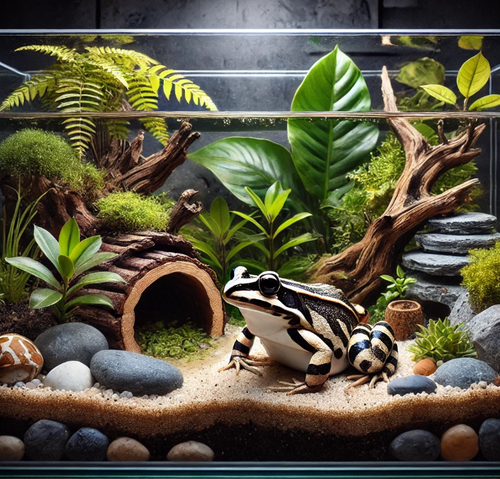Enhancing a Temperate Frog Enclosure: Creating the Perfect Habitat for Your Amphibian Friends
Posted by BioSupplies on 5th Jul 2024
Temperate frogs, such as the Striped Marsh Frog and Ornate Burrowing Frog, thrive in environments that mimic the moderate conditions of temperate regions. Here’s how to set up and enhance a temperate frog enclosure to keep your amphibian friends happy and healthy.
Understanding the Temperate Frog’s Natural Habitat
Temperate frogs prefer moderate humidity and temperature variations between day and night. Their natural habitat often includes both terrestrial and aquatic elements, providing a diverse environment.
Setting Up the Basics
- Tank Size and Type
- Size: A 40 litre tank is suitable for smaller temperate frogs, but larger species or multiple frogs will need a 75 litre or larger tank.
- Material: Glass tanks are commonly used for their durability and visibility. Ensure the tank has a secure lid to prevent escapes.
- Substrate
- Use substrates like coconut fiber, soil, or a mix of soil and leaf litter. These materials provide a natural feel and help retain moisture without becoming waterlogged.
- Heating and Lighting
- Temperature: Maintain a temperature range of 18-24°C during the day and slightly cooler at night.
- Lighting: Provide a day/night cycle with appropriate lighting.
- Humidity Control
- Install a hygrometer to monitor humidity levels. Temperate frogs thrive at humidity levels between 50-70%.
- Use a misting system or manual misting to maintain proper humidity. A shallow water dish can also help maintain humidity.
Enclosure Design and Enrichment
- Plants and Foliage
- Use live or artificial plants to create a natural environment. Live plants help maintain humidity and provide hiding spots. Suitable plants include ferns and mosses.
- Hides and Climbing Structures
- Provide hiding spots using cork bark, hollow logs, or commercially available hides. Include some climbing structures, especially for tree-dwelling species.
- Water Features
- Include a shallow water area with clean, dechlorinated water. Use a filter to keep the water clean and change it regularly.
- Feeding Stations
- Create designated feeding areas for live food such as crickets, mealworms, or flies. This helps keep the enclosure clean and allows you to monitor your frog's feeding habits.
- Regular Maintenance
- Clean the enclosure regularly to prevent mold, bacteria, and waste buildup. Spot clean daily and perform a deep clean every few weeks.
Observing and Interacting with Your Frogs
- Behavioral Observation
- Spend time observing your frogs to understand their behaviors and preferences. This can help you make necessary adjustments to their environment.
- Handling
- Minimize handling to reduce stress. When necessary, handle frogs with clean, wet hands to avoid transferring harmful substances.
- Health Monitoring
- Keep an eye on your frog’s health, looking out for signs of illness such as changes in appetite, skin discoloration, or lethargy. Consult a veterinarian experienced with amphibians if you notice any concerning symptoms.
By understanding and replicating the natural habitat of temperate frogs, you can create an enriching and comfortable environment that promotes their health and happiness.

